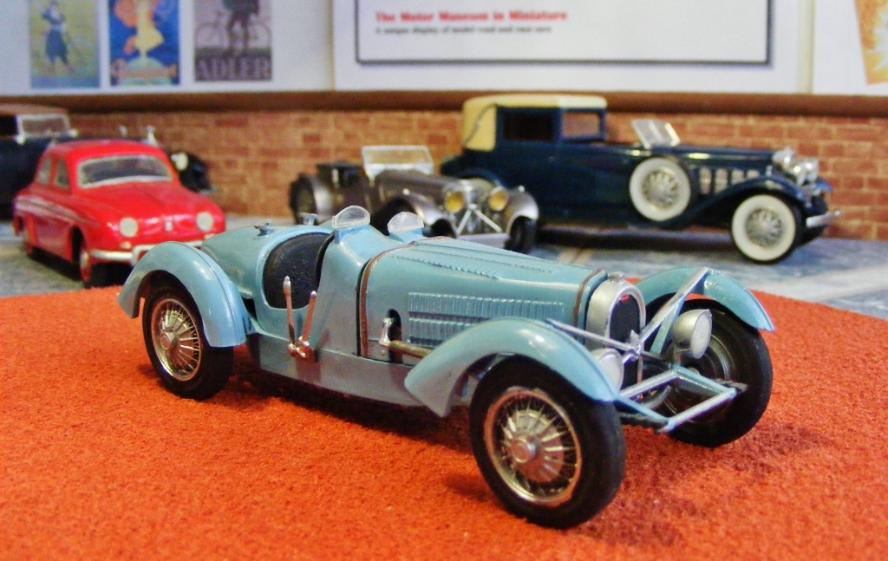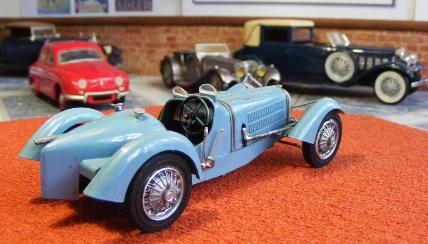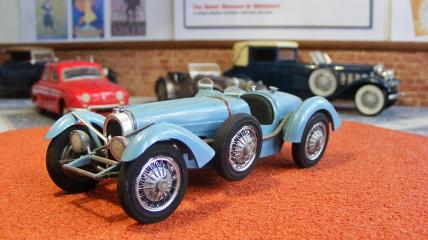
1935 Bugatti Type 59
The Bugatti Type 59, was designed for 1933 but didn't make its debut until late in 1933 season. There is no doubting Ettore Bugatti was a great designer but his stubborn conservatism proved a handicap to his cars. Built to conform to the new '750 kg' regulations of 1934 the T59 looked rather old fashioned compared to the new German machines. While the elegance of the familiar look remained alluring the use of beam axles and cable operated drum brakes was out of step with the opposition's use of independent suspension and hydraulic brakes. Bugatti also insisted in keeping a 2-seat option but in a way having the driver's seat off-set to the right compensated for the fact that the prop-shaft still ran down the centre of the car. Fitted separately between the engine and rear-axle was a four-speed gearbox with external gear lever. The straight-8 engine appeared little more than a bored out T54 unit but it was a new design intended to power not only the new T59 but also the T57 Grand Touring car. Initially run in 2.8ltr form it was soon enlarged to 3.3ltr (3257cc). It featured 2 valves per cylinder operated by dual over-head cam's, 6 plain bearings on the crankshaft instead of the earlier roller bearings and the GP version had dry-sump lubrication. The two Zenith carburettors fed a Roots-type supercharger putting 250hp on demand.
The steel ladder chassis from the T54 was drilled to reduce weight and with the engine set much lower in the frame the car had a lower centre of gravity for better cornering. These characteristics were assisted by the rigid engine mounting providing strength and stability while the rear of the chassis remained intentionally flexible to aid handling. Suspension was by live axle with semi-elliptical springs at the front and inverted quarter-elliptical springs at the rear. The hollow front axle allowed a small amount of independent front suspension due to being split in the centre and joined by a collar.
Although the T59 had a familiar looking all-aluminium bodywork, from the horse-shoe grille to pointed tail, of the earlier GP Bugatti’s it was noticeably lower, largely due to the underslung rear suspension and the engines dry-sump. A testament to Bugatti’s design ability is the fact that his design tweaks kept these 'old fashioned' cars relatively competitive. Ideas like the beautiful piano wire wheels. The majority of the torque load went through the rim and an aluminium back plate which were reinforced by the brake drum. The wheel rim engaged directly to the brake drum by a system of teeth on the outer aspect of the drum and the inner aspect of the wheel rim. The spokes helped handle the lateral cornering loads; as a combined unit the wheels were strong and light.
Only 6 were made as hoped for sales did not materialise. The car was outclassed by far superior German technology and by Alfa Romeo's P3, so little success came Bugatti s way. During 1934, Dreyfus and Brivio drove T59's to first and second positions in the Belgian GP, although the German entries were withdrawn and the Alfa's both failed to finish, Wimille won the Algiers GP.
In 2012 an authentic T59 is worth an estimated £2.5Million, possibly more.






This kit is from Pyro and is included as #17 in their 1/32nd scale “Table Top Series” of kits. Titled as “Bugatti Grand Prix race Car”, under the catalogue C303, later as C303-60 the mould was a completely new tooling which first produced kits in 1965. Today it is a very rare kit having, apparently, not being re-released by Pyro. Only a release by Life-Like Hobby Kits/Hales kit #C-79 in the 1970s gives any clue to what may have happened to the moulds.
Built by Rod in the 1960s. It is straight from the box and painted with Humbrol enamels applied by brush. It is now a period piece, an example of the kit manufacturing and hobby techniques of the era.

